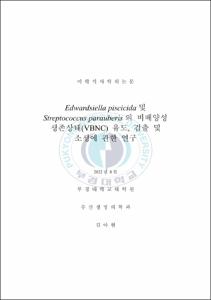Edwardsiella piscicida 및 Streptococcus parauberis의 비배양성 생존상태(VBNC) 유도, 검출 및 소생에 관한 연구
- Abstract
- Viable but non-culturable (VBNC) cells of many bacterial species, one of their survival mechanisms under unfavorite environment, are not grown in artificial culture media. The aim of this study was to investigate conditions for and properties of VBNC induction and resuscitation of Edwardsiella piscicida and Streptococcus parauberis, and pathogenicity of VBNC cells of the two important fish pathogens. For VBNC induction, in this study, filtered sterile seawater was used for starvation of the two bacteria and they were maintained at different temperatures (4, 10, and 25°C). For resuscitation, temperature was upshifted or nutrients were added to VBNC cells, and observed for 7 days. Also, in this study, quantification methods (PMA-qPCR) for VBNC state of the two pathogens were developed by optimizing concentration of propidium monoazide (e.g., 0, 10, 20, 40, 100 μM) and light intensity and exposure time (0, 5, 15, 30 min). As a result, both species entered the VBNC state approximately 1 month after incubation at 4°C and 25°C, and ~ 2 months at 10°C, which were measured by PMA-qPCR, indicating that time required for VBNC induction could be different depending on incubation temperatures. VBNC cells did not always regain culturability, but they were resuscitated under enriched nutrition and higher temperatures (28°C) within 2, 3 days. Although resuscitated cells showed pathogenicity similar to normal bacterial culture, fish intraperitoneally injected with VBNC cells did not show any signs of disease and mortality, suggesting that these two pathogens in VBNC state is not likely to resuscitate in fish peritoneal cavity. This study shows that bacterial fish pathogens can enter into VBNC state depending on environmental conditions (e.g., low water temperature and seasonal changes) and contributes better understanding of the ecology of the bacteria.
불리한 환경에서 세균의 생존기작 중 하나인 viable but non-culturable (VBNC)는 배지에서 거의 분리되지 않지만 낮은 대사활성 수준을 유지하고 있다. 본 연구의 목적은 국내 양식어류에 피해를 일으키는 중요 어병 세균인 Edwardsiella piscicida 와 Streptococcus parauberis의 VBNC 유도 및 소생 시 조건과 특성을 파악하고 두 병원체의 VBNC 세포의 병원성을 조사하는 것이다. VBNC 유도를 위해 여과된 멸균해수를 사용하여 세균을 기아상태로 만들고 세가지 다른 온도(4, 10, 25°C)에서 유지하였다. 소생을 위해서는 VBNC 세포에 온도를 높이거나 영양을 첨가하여 7일동안 소생여부를 관찰하였다. 또한, 본 연구에서는 propidium monoazide 농도(예: 0, 10, 20, 40, 100 μM)와 빛 노출시간(예: 0, 5, 15, 30분)을 최적화하여 두 병원균의 VBNC 상태를 포함한 생균에 대한 정량화 방법(PMA-qPCR)을 개발하였다. 그 결과, 두 종 모두 PMA-qPCR로 측정하였을 때 4°C 및 25°C에서 약 1개월, 10°C에서 약 2개월 후에 VBNC 상태에 진입하여 VBNC 유도에 필요한 시간이 배양 온도에 따라 다를 수 있음을 확인하였다. 또한, VBNC 세포가 항상 배양성을 회복하는 것은 아니지만 영양이 풍부한 환경과 높은 온도(28°C)에서 2, 3일 이내에 소생되었다. 소생된 세포는 정상적으로 배양된 세균과 유사한 병원성을 나타냈지만 VBNC 세포를 복강 내 주사한 어류는 질병 및 사망의 징후를 나타내지 않았으며, 이는 VBNC 상태의 이 두 병원체가 어류 복강 내에서 소생할 가능성이 없음을 시사하였다. 이번 연구는 어병 세균이 환경조건(예: 낮은 수온 및 계절 변화)에 따라 VBNC 상태에 들어갈 수 있음을 보여주었으며 세균 생태에 대한 더 나은 이해에 기여할 수 있을 것이다.
- Issued Date
- 2022
- Awarded Date
- 2022. 8
- Type
- Dissertation
- Publisher
- 부경대학교
- Affiliation
- 부경대학교 대학원
- Department
- 대학원 수산생명의학과
- Advisor
- 김도형
- Table Of Contents
- Ⅰ. 서론 1
Ⅱ. 재료 및 방법 5
1. 시험 균주 5
2. VBNC 유도 5
2.1. VBNC 유도 과정 5
2.2. Microcosm 내 세균 수 정량 6
2.3. VBNC 생존력 확인 6
3. VBNC의 소생 7
4. VBNC 균과 소생균의 병원성 7
5. Propidium monoazide (PMA) - qPCR assay의 최적화 및 VBNC 정량 8
5.1. Heat-killed cell 제작 8
5.2. 최적 qPCR primer 탐색 8
5.3. PMA 농도 및 빛 노출시간 설정 11
5.4. 생균 및 사균 혼합물에 대한 PMA-qPCR assay 11
5.5. DNA 추출 및 quantitative PCR 12
6. 통계분석 13
Ⅲ. 결과 14
1. PMA-qPCR의 최적 조건 14
2. PMA-qPCR의 효율 및 검출한계 19
3. 생균 및 사균 혼합물에 대한 PMA-qPCR 한계 19
4. VBNC 유도 중 세균 수 변화 및 형광현미경 관찰 22
5. VBNC의 소생 27
6. VBNC 균과 소생균의 병원성 확인 29
Ⅳ. 고찰 31
국문요약 37
참고문헌 38
- Degree
- Master
- Files in This Item:
-
-
Download
 Edwardsiella piscicida 및 Streptococcus parauberis의 비배양성 생존상태(VBNC) 유도, 검출 및 소생에 관한 연구.pdf
기타 데이터 / 2.1 MB / Adobe PDF
Edwardsiella piscicida 및 Streptococcus parauberis의 비배양성 생존상태(VBNC) 유도, 검출 및 소생에 관한 연구.pdf
기타 데이터 / 2.1 MB / Adobe PDF
-
Items in Repository are protected by copyright, with all rights reserved, unless otherwise indicated.